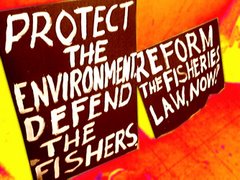The Tañon Strait Oil and Gas Project
Dr. Angel C. Alcala
Sometime ago this year, an assistant secretary of the Department of Energy and a Japanese official of the Japan Petroleum Exploration co., Ltd. (JAPEX) came to see me in my office at the SU Angelo King Center for Research & Environmental Management to explain this project.
From that meeting, I gathered that this gas exploration project is planned to be carried out in the Tañon Strait off Aloguinsan and Pinamungajan, Cebu.
The direct impact area has a radius of 1.5 kms and the secondary impact area has a radius of five kms. The project will use a floater rig.
The project plans to drill this year a well 3,000 meters below the sea surface. Drill cuttings will not be discharged to the immediate area but will be collected and dumped into the sea elsewhere, I was told.
Because the project is exploratory, the Environmental Compliance Certificate (ECC) is not necessary according to the DENR, and only an Initial Environmental Examination (IEE) is needed. A copy of this IEE was given to me for our review.
In this IEE, a list of five groups of data is presented in a table. Another table listed eight names that composed the EIA Study Team, some of them I know personally. It is assumed that the report of this team is the basis for the environmental and resource information discussed in the IEE. This information was reviewed by our team of marine biologists at SUAKCREM, which is the subject of today’s column.
Our review concluded that the environmental and resource survey was extremely rapid, lacking in critical data essential for valid and meaningful comparisons in order to determine the impacts of the exploratory drilling. The following discussion gives the details:
The baseline data (DENR 7 PCRA) are too old and not suitable for the project. PCRA data are meant for use by stakeholder communities, and not suitable for the project, and a more detailed technical methodology was not presented. This is needed for an environmentally sensitive project such as this one. A more detailed technical assessment of marine habitats is required. The methodology has to be properly documented (examples, how many transects were surveyed by what procedures, density of fishes and other marine organisms per unit area, total number of target species, of indicator species, etc.)
Fish densities presented were too low – 2,000 fish individuals per square kilometer; we have found 2,000 individuals per 500 square meters around Cebu and Negros; something wrong here!
To put it bluntly, the methodology employed, and consequently, the data gathered, do not meet acceptable standards, cannot be used as baselines for future monitoring of drilling effects, and therefore, not acceptable.
Of prime importance is the construction of a fisheries profile. For this, the IEE document should be clear on how the data are gathered so they can be verified for credibility in any future inquiry.
On fish data composition (p.39, Chap. 5), technical data and graphs with units need to be presented so they can be compared to other existing data within the whole country.
On catch composition per gear type, the data presented are old (2001). If the catch was this bad back in 2001, it is expected to be worse now. A proper catch per unit effort spans at least one year, and not done instantly. A detailed methodology was not presented in the study.
Substrate types were not determined, and major coral growth forms were not reported including those most vulnerable to pollution such as sedimentation. Susceptibility of vulnerability indices of sites was not assessed.
The disposal of drill cuttings presents a problem. One area identified is the Sulu Sea. But the Sulu Sea is a prime fishing area and has high biodiversity! Dumping cuttings into this sea unnecessarily creates additional problems.
In brief, we found the IEE document wanting in the critical survey data and information needed for determining the environmental and socio-economic impacts of the proposed drilling operation of JAPEX.





No comments:
Post a Comment